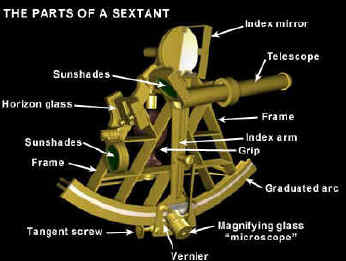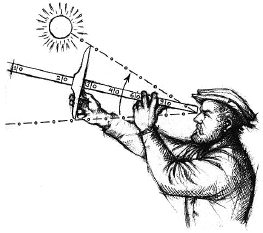Navigation Tools
| YOSSARIAN:
Let me see if I've got this straight: in order to be grounded,
I've got to be crazy and I must be crazy to keep flying. But if
I ask to be grounded, that means I'm not crazy any more and I
have to keep flying.
Catch
22 |
D Vautier
6/2019
 The ancients realized that the earth was round and
they needed tools to help them locate where things were. The first
such attempts used towers that would track the suns shadow at various
locations. A more advanced angle measuring device however was the
astrolabe which looks more like an ornament than anything else. It was a flat disk often heavily decorated with lines and symbols
of deities and sea monsters, with an arm to measure angular elevation.
The instrument had to be held perpendicular to get an accurate
reading which was not very accurate unless you had real sturdy arms and
a lot of luck.
The ancients realized that the earth was round and
they needed tools to help them locate where things were. The first
such attempts used towers that would track the suns shadow at various
locations. A more advanced angle measuring device however was the
astrolabe which looks more like an ornament than anything else. It was a flat disk often heavily decorated with lines and symbols
of deities and sea monsters, with an arm to measure angular elevation.
The instrument had to be held perpendicular to get an accurate
reading which was not very accurate unless you had real sturdy arms and
a lot of luck.
 The cross staff also probably dates from antiquity.
It consists of a sliding bar on a pole that contains a graduated
scale. Early mariners used
these devices which like the astrolabe were not very accurate and
depended upon the skill of the user.
The cross staff also probably dates from antiquity.
It consists of a sliding bar on a pole that contains a graduated
scale. Early mariners used
these devices which like the astrolabe were not very accurate and
depended upon the skill of the user.
The
back staff was perhaps an improvement over the cross staff but not by
very much. At least it saved
the user from squinting at the sun.
It is unclear who first invented
the sextant, the American Thomas Godfrey or the Englishman John Hadley
around 1731 but this device represented the highest degree of precision
in the entire evolution of angle measuring
devices. The important thing
is that it was very accurate at measuring angles and could be used on
the moving deck of a ship.
 Another
type of instrument the octant did about the same thing but was not quite
as accurate or made as well.
Another
type of instrument the octant did about the same thing but was not quite
as accurate or made as well.
The importance of the sextant is hard to
underestimate, because without it, no other method of reasonable geographical
location would
be possible.
By the end of the 1700s there
were two ways to calculate longitude, the lunar distance method and the
chronometer method. Both
ways required instruments that measured angles between celestial bodies
and horizons; the better the instrument, the more precise a
determination could be made.


a
back staff and cross staff in action
Another
device, the log-ship (Cronin, 10) was a rough way to determine the speed
of a vessel. It consisted of
a flat weighted board configured like a kite that was attached to a long
rope containing equally spaced knots. The log-ship was cast overboard and the rope fed out.
After one minute or so (using a sand glass) it was dragged back
on board and the knots were counted. Thus the ship was said to be doing so many knots.
 The ancients realized that the earth was round and
they needed tools to help them locate where things were. The first
such attempts used towers that would track the suns shadow at various
locations. A more advanced angle measuring device however was the
astrolabe which looks more like an ornament than anything else. It was a flat disk often heavily decorated with lines and symbols
of deities and sea monsters, with an arm to measure angular elevation.
The instrument had to be held perpendicular to get an accurate
reading which was not very accurate unless you had real sturdy arms and
a lot of luck.
The ancients realized that the earth was round and
they needed tools to help them locate where things were. The first
such attempts used towers that would track the suns shadow at various
locations. A more advanced angle measuring device however was the
astrolabe which looks more like an ornament than anything else. It was a flat disk often heavily decorated with lines and symbols
of deities and sea monsters, with an arm to measure angular elevation.
The instrument had to be held perpendicular to get an accurate
reading which was not very accurate unless you had real sturdy arms and
a lot of luck.
 The cross staff also probably dates from antiquity.
It consists of a sliding bar on a pole that contains a graduated
scale. Early mariners used
these devices which like the astrolabe were not very accurate and
depended upon the skill of the user.
The cross staff also probably dates from antiquity.
It consists of a sliding bar on a pole that contains a graduated
scale. Early mariners used
these devices which like the astrolabe were not very accurate and
depended upon the skill of the user. Another
type of instrument the octant did about the same thing but was not quite
as accurate or made as well.
Another
type of instrument the octant did about the same thing but was not quite
as accurate or made as well.

